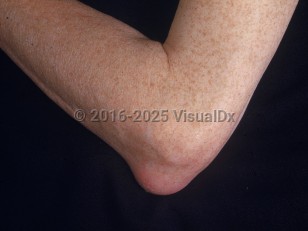Bursitis
Alerts and Notices
Important News & Links
Synopsis
The location of bursae may be superficial (olecranon, patellar, infrapatellar, retrocalcaneal) or deep (anserine, subacromial, trochanteric, iliopsoas).
Commonly affected bursae are those over the extensor surfaces of the elbow (olecranon bursitis) and knee (prepatellar bursitis). Other commonly encountered bursitis sites are trochanteric bursitis near the greater trochanter of the femur and pes anserine bursitis over the anteromedial aspect of the tibia.
The etiology for bursitis is varied and can relate to the location of the bursitis. Generally bursitis is broken down into two broad categories: septic and nonseptic bursitis. Nonseptic bursitis may occur in the setting of inflammatory arthritis (eg, rheumatoid arthritis), trauma / injury, or prolonged localized pressure, or may be crystal induced (ie, gout or calcium pyrophosphate disease [CPPD]) or idiopathic. Shoulder bursitis may occur after routine vaccinations, often related to the position of the injection.
Septic bursitis usually results from trauma leading to direct inoculation of a bursa but may also be secondary to blunt trauma, a skin wound, or repetitive pressure applied over a joint. The source of infection is often from adjacent tissue, and overlying cellulitis may be associated with bursitis. Staphylococcus aureus is the most commonly isolated pathogen in septic bursitis.
Bursitis can occur at any age, but it is more commonly seen in adults and in the setting of overuse injuries. Repetitive activities (from sports or work) and certain occupations (laborer, gardener, mechanic, miner, and carpet layer) put one at greater risk for acquiring bursitis. Long-distance running is a risk factor for anserine bursitis. Trochanteric bursitis occurs more often in females than in males and has been associated with obesity, degenerative joint disease, and ipsilateral and contralateral hip arthritis. Certain health conditions such as gout, CPPD, and rheumatoid arthritis are predisposing factors, especially for olecranon and prepatellar bursitis. Risk factors for septic bursitis include having a suppressed immune system, such as those patients with malignancy, leukopenia, diabetes, renal failure, or recent use of systemic glucocorticoids.
Codes
M71.50 – Other bursitis, not elsewhere classified
SNOMEDCT:
84017003 – Bursitis
Look For
Subscription Required
Diagnostic Pearls
Subscription Required
Differential Diagnosis & Pitfalls

Subscription Required
Best Tests
Subscription Required
Management Pearls
Subscription Required
Therapy
Subscription Required
Drug Reaction Data
Subscription Required
References
Subscription Required

